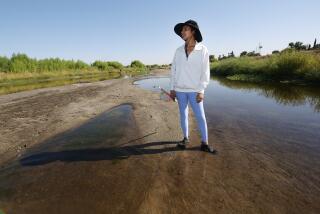L.A. falling short on river, judge says
Less than three months ago, the Los Angeles Department of Water and Power let water flow once more into a nearly dry Inyo County riverbed as part of one of the largest river restoration projects in the nation. But now a judge says the department’s efforts are still falling short.
Environmentalists on Tuesday cheered the judge’s comments as city officials defended their actions to restore the river. Indeed, the judge lauded the city for establishing a steady flow of water -- 40 cubic feet per second -- in the riverbed well before a July 25 deadline to do so.
But in a ruling issued late Monday, Inyo County Superior Court Judge Lee E. Cooper said city water authorities had constructed only nine of 17 water-monitoring stations called for in the Lower Owens River, about 200 miles north of Los Angeles. In addition, the water measurements provided by the DWP have been inadequate, he said.
As a result, Cooper denied a request by Los Angeles City Atty. Rocky Delgadillo to lift sanctions that the judge imposed on the city for failing to restore the river in a timely manner. In addition to imposing sanctions, Cooper has threatened to bar the city from using the so-called Second Los Angeles Aqueduct if it continues to delay full implementation of the project.
“In the record before me, I cannot find the city has complied with all the conditions,” the judge wrote in his ruling. “All means all, not just some of the conditions!”
Cooper praised the DWP for “proceeding with commendable diligence.” He added that “regrettably, however, given the history of the Lower Owens River Project, a certain level of skepticism by other parties about DWP’s representations is understandable.”
The DWP has missed at least 14 deadlines connected to the project. Water still flows in the Upper Owens River, but then it is diverted into the aqueduct by a dam about midway between the communities of Independence and Big Pine. This, plus groundwater pumping, left the Lower Owens essentially dry for decades. Since December, however, some water has been channeled back into the lower river at the dam.
Cooper has imposed fines of $5,000 a day until water is flowing in the Lower Owens at 40 cubic feet a second, along with other conditions. The fines began accruing Sept. 5, 2005.
In reference to Delgadillo’s request, David Nahai, president of the DWP’s Board of Commissioners, said, “We cannot be criticized for attempting to lift the burden of a $5,000-a-day fine against the city at the earliest opportunity.”
Nahai called the project “a showcase of our scientific and technical prowess. It is also an example of our reinforced sense of environmental responsibility in this city.”
The DWP was also ordered to reduce by a third its pumping of water out of the Lower Owens Valley. Failure to comply with his ruling, the judge warned, would result in a permanent injunction against using the Second Los Angeles Aqueduct, an $89-million facility that has been exporting millions of gallons of water to Southern California since 1970.
“That’s a huge hammer hanging over the city’s head,” said Don Mooney, an attorney for the Owens Valley Committee, which in 2001 filed a lawsuit with the Sierra Club against the DWP. Later the California Department of Fish and Game and the State Lands Commission joined the suit.
“The city is on notice; there are clear consequences for failing to comply,” Mooney said. “Yet somebody in Los Angeles made the decision to build only nine stations and never bothered to ask the court to modify its order.”
Cooper urged the warring parties to “see if these issues can be resolved informally.”
The impact on the environment of adding more water-measuring stations will be considered in future talks with environmental groups.
“We are in a position to negotiate with Los Angeles,” said Mooney, who declined to elaborate.
*
More to Read
Sign up for Essential California
The most important California stories and recommendations in your inbox every morning.
You may occasionally receive promotional content from the Los Angeles Times.











